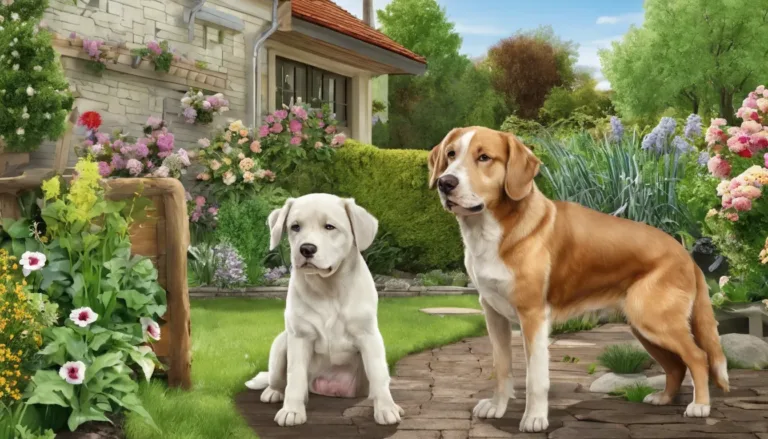Gardening and dog care are both rewarding activities, but combining the two can present its own unique set of challenges. How to care for a dog in the garden? This crucial question arises for pet owners who wish to maintain a beautiful, thriving garden while ensuring the safety and happiness of their furry companions. From preventing dogs from digging up freshly planted beds to safeguarding them against poisonous plants, the balance between garden design and dog behavior requires thoughtful planning and ongoing attention. dog garden care
This article delves into essential tips on creating a dog-friendly garden layout that accommodates the playful nature of dogs while preventing common problems such as chewing, digging, and other undesirable dog behaviors. It covers the fundamentals of garden planning, from choosing the right fencing and lawn care practices to the strategic placement of plant supports and garden paths. Additionally, maintaining garden and dog safety through careful selection of non-toxic plants, effective dog training, and regular garden maintenance will be explored. By addressing these key areas, pet owners can enjoy the dual pleasures of a well-kept garden and the joyful companionship of their dogs in a safe, welcoming environment. dog garden care
Care for a Dog in the Garden
Planning a Dog-Friendly Garden Layout
Understanding Dog Behavior in Gardens
To create a garden that both thrives and accommodates a dog’s natural behaviors, it’s crucial to understand how dogs interact with outdoor spaces. Dogs exhibit a variety of behaviors based on their breed and individual personality, which can influence their interaction with garden elements. For instance, some dogs may exhibit a strong instinct to patrol the boundaries of their territory, often creating worn paths along fence lines [1]. Recognizing these behaviors allows gardeners to integrate features that address the dog’s needs without compromising the garden’s aesthetics or functionality.
Designing Paths and Routes
Incorporating designated paths and routes in the garden layout can significantly enhance its dog-friendliness. Creating clear, defined pathways helps guide dogs through the garden, minimizing the risk of trampling delicate plants or flower beds. These paths can be made from dog-friendly materials such as smooth decorative stones or permeable pavers, which are both aesthetically pleasing and functional [1] [2]. Additionally, paths should follow the natural routes that dogs tend to take, turning their usual tracks into official parts of the garden’s design. This not only prevents damage to other areas but also satisfies the dog’s instinct to patrol and protect its territory [1].
Placing Garden Beds Strategically
Strategic placement of garden beds is key to preventing dogs from causing unintentional damage. Raised beds or beds with sturdy borders such as stone or low fencing can deter dogs from entering these areas [1] [2]. Planting dense groupings or using larger, more robust plants can create natural barriers that dogs are less likely to disturb [1]. For gardens with particularly active or curious dogs, it might be beneficial to designate a specific area of the garden for the dog, complete with dog-friendly plants and a sandbox for digging. This allows dogs to have a space of their own without compromising the rest of the garden’s integrity [3].
By understanding and accommodating the natural behaviors of dogs, gardeners can design a space that is enjoyable and safe for both their plant collections and their furry friends. dog garden care
Maintaining Garden and Dog Safety
Routine Safety Checks
Regular inspections of the garden are essential to ensure it remains a safe environment for dogs. Owners should look for potential escape routes or hazardous areas where a dog might attempt to dig or jump over barriers. Installing smooth-surfaced fences with roll-bars and an inward-facing 45° section at the top can help manage most hardened jumpers [4]. Additionally, laying a hard substrate like cement, covered with solid chicken wire and then stones or gravel, can prevent dogs from digging under fences [4].
Using Safe Pest Control Methods
Choosing pet-safe pest control methods is crucial to maintaining a healthy garden without risking a dog’s health. Organic options like neem oil and diatomaceous earth are effective against a wide range of pests and are safe for dogs, birds, and beneficial insects [5]. Avoiding toxic chemicals is paramount; instead, use natural pest-control solutions that balance garden health with pet safety [6] [5].
Protecting Water Areas
Water features in a garden can enhance its beauty but pose risks to dogs. Ensuring that ponds have barriers or are raised above ground level can prevent dogs from accessing the water [7]. For those who prefer not to have open water, consider alternatives like mist machines that create a water fog without the hazards of a pond [7]. Always supervise puppies around water features to prevent accidents [7].
Making the Garden Comfortable for Dogs
Providing Shade and Shelter
Dogs can overheat quickly due to their insulating fur coats, making shade an essential feature in any dog-friendly garden. One innovative solution is using a flower planter as a base for an umbrella, providing shade at ground level where dogs typically play [8]. Additionally, landscape fabric draped over a chain-link run offers a breathable shade option that blocks UV rays without restricting air flow [8]. For a more flexible solution, sun sail kits can be installed to create large shaded areas, using UV-resistant material that also allows rain to pass through, preventing any pooling [8]. Those seeking a more permanent solution might consider constructing a pet-sized pergola with wooden pallets, which offers shade while ensuring ample air circulation [8].
Adding Cooling Elements like Ponds
Incorporating water features can significantly enhance a dog’s comfort during hot weather. A simple addition like a kiddie pool provides an immediate cooling spot and can be a source of fun for water-loving dogs [9]. For a more integrated approach, consider designing a dog-friendly pond that not only cools but also adds aesthetic value to the garden [9]. Such features should always be designed with safety in mind, ensuring that they are accessible yet secure to prevent any accidental drowning risks.
Choosing Comfortable Walking Surfaces
The choice of materials for paths and walkways in a dog-friendly garden is crucial for the comfort and safety of pets. Smooth flagstones are recommended for their flat, stable surface that is gentle on paws and visually appealing [10]. Pea gravel and concrete pavers are other suitable options, offering durability and comfort for daily walks [10]. For those preferring a green look without the maintenance, artificial turf can be an ideal alternative, providing a soft and cleanable surface for dogs to play on [10]. Additionally, ensuring that these pathways are well-integrated into the garden layout can help prevent dogs from straying into plant areas, thus maintaining both the garden’s beauty and functionality [10].
Dealing with Common Issues
Preventing Digging and Chewing
Dogs often engage in digging and chewing due to boredom or natural instincts. To mitigate these behaviors, providing sufficient exercise and mental stimulation is crucial. Regular walks and playtime can significantly reduce a dog’s urge to dig and chew [11]. Additionally, creating a designated digging area in the yard encourages dogs to dig in an acceptable spot, which can be enhanced by burying toys or treats for them to find [11]. Using natural deterrents like citrus peels, vinegar, or cayenne pepper in areas prone to these behaviors can also discourage dogs from engaging in these activities [11].
Managing Plant Damage
When dogs pull out plants, immediate redirection is key. Catching them in the act and redirecting their attention to appropriate activities such as playing with a toy or engaging in a training exercise can prevent the habit from forming [11]. For gardens, using sturdy barriers around plants and employing bitter-tasting sprays on foliage can keep dogs at bay. Products like Bitter Yuck and Bitter Apple have been shown to be effective, although their effects may diminish and require reapplication [12].
Preventing Toxic Plant Exposure
The most effective way to prevent toxic plant exposure is to ensure that these plants are not accessible to dogs either inside or outside the home [13] [14]. Familiarizing oneself with the list of toxic plants and symptoms of poisoning can provide crucial information for quick action in case of accidental ingestion. Immediate consultation with a veterinarian or the Pet Poison Helpline is recommended if there is any suspicion of poisoning [13] [14]. Symptoms to watch for include vomiting, diarrhea, drooling, and more severe signs such as seizures or collapse [13].
By implementing these strategies, dog owners can address common issues effectively, ensuring both the safety of their dogs and the integrity of their gardens.
Conclusion
Throughout this exploration of managing a harmonious existence between dogs and gardens, we’ve delved into the critical considerations of planning, safety, comfort, and behavior management. By understanding and accommodating the natural tendencies and needs of our canine companions, we can create outdoor spaces that fulfill the aesthetic and functional demands of gardening while ensuring a safe, stimulating, and enjoyable environment for dogs. Recognizing that the success of this balance hinges on thoughtful design, regular maintenance, and proactive measures, we’ve highlighted the importance of strategic garden layout, the use of dog-friendly materials, and the adoption of safe pest control methods.
As we conclude, it’s clear that the key to a thriving garden that welcomes dogs lies in the attentive integration of their behaviors and needs into the garden’s design and routine care. Emphasizing non-toxic planting, secure boundaries, and engaging features like shade, shelters, and water elements not only enhances the garden’s beauty and usability but also significantly contributes to the well-being and happiness of our four-legged friends. Moreover, this approach fosters an ongoing partnership between gardener and pet, reinforcing the joy and satisfaction derived from nurturing living spaces that flourish and evolve. In embracing these practices, we pave the way for a more inclusive and harmonious coexistence that enriches both our lives and those of our beloved pets.
FAQs
1. How can I safeguard my garden from my dog?
To protect your garden, place thorny branches intermittently in freshly mulched or seeded areas or soft soil. You can also surround entire beds with chicken-wire fences. To make the fence less noticeable, install tall stakes around the perimeter of the bed.
2. What are the best practices for keeping a dog safe in the garden?
To ensure your dog’s safety outdoors, check the weather conditions and avoid extreme temperatures. Provide ample water, shade, and shelter. Engage your dog with toys and exercise, limit their time outside, and consider building a tall fence. It’s important to avoid tying or chaining your dog outdoors.
3. How can I maintain a garden while having a dog?
Consider planting in robust containers like horse troughs or large pots. Use hanging baskets or plant shelves to keep your plants out of reach from your dog. Raised beds can also help separate the growing areas from play areas, and using barriers like chicken wire can prevent your dog from accessing them.
4. What strategies can prevent my dog from damaging the garden?
To prevent your dog from destroying your garden, use barriers or paths to protect vulnerable areas, especially around flower beds. You might also need to rethink your garden’s layout to make it more dog-resistant. Additionally, creating a specific area for your dog to dig and selecting plants that are resilient to dogs can be effective.
References
[1] – https://www.sunset.com/garden/backyard-projects/dog-friendly-gardens
[2] – https://richardrogersdesigns.com/garden-design-tips-for-creating-a-dog-friendly-garden/
[3] – https://millcreekgardens.com/creating-dog-friendly-yard-garden/
[4] – https://www.woofliketomeet.com/2018/10/keeping-your-dog-safe-in-the-garden/
[5] – https://www.thewildest.com/pet-lifestyle/pet-safe-pesticides
[6] – https://news.orvis.com/dogs/dog-safe-garden-pest-control
[7] – https://gardeninganddogs.com/gardening/every-garden-should-have-some-water/
[8] – https://www.shadingtexas.com/10-easy-dog-shade-ideas/
[9] – https://www.bindisbucketlist.com/post/the-sensory-yard-making-our-backyard-into-a-sensory-heaven-for-our-dogs
[10] – https://ryserslandscapesupply.com/pet-friendly-landscaping-safe-and-beautiful-options-for-your-furry-friends/
[11] – https://www.quora.com/How-do-I-stop-my-dog-from-digging-and-pulling-plants-out
[12] – https://www.wildinteriors.com/blog/how-to-keep-pets-away-from-plants
[13] – https://www.petmd.com/dog/poisons/plants-poisonous-to-dogs
[14] – https://www.akc.org/expert-advice/home-living/poisonous-plants-for-dogs/
Dog Care

